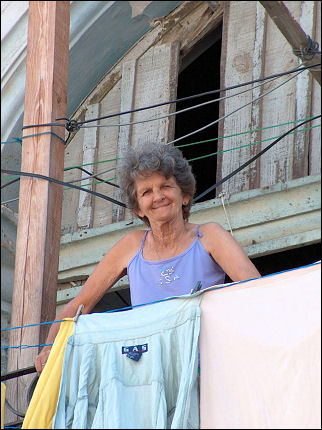
|
Surprising Cuba
Pastel-colored houses
and green valleys
Cuba has a nice mix of nature and culture. In a rental car from Varadero via Havana to the Valley of Vinales, which is explored on horseback. In Trinidad everyone begs for soap. Camagüey is an atmospheric city and in Bayamo life is good: lots of sun and beer. In the Sierra Maestra coffee is grown and chickens, pigs and goats roam free everywhere. Santiago de Cuba is remarkable for its colorful buildings. Baracoa is an extraordinary town, Caya Coco has a white beach and turquoise water. The landscapes are pretty, the roads often terrible and our backseats are usually occupied by hitchhikers, among whom many a police officer. Spending the night in a casa particular, one gets to know the population.
Travelogue: Joska Jalving
Photos: Alexander Kikkert & Joska Jalving
Varadero
White sand, turquoise water and palm-leave parasols
At the Varadero airport, all cars are old. The first sign that we're on Cuba. Because tourists have to book a hotel, we did. A bus takes us to a tourist resort. We pass some kind of toll gate (only tourists and Cubans who work in Varadero can pass) and see one hotel after another, dilapidated wooden houses, old cars and oil pumps. The hotel has an all-you-can-eat grub shed.
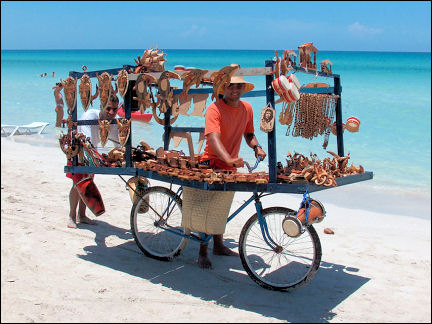
|
There is a reason it's so crowded in Varadero. The beaches are beautiful: white sand, turquoise water and palm-leave parasols.
A kind of tourist coach takes us to Havana. The guide talks about his country. Milk is very expensive and scarce; it's mainly given to children and the elderly. Beef is unaffordable. We see a lot of vultures from the bus.
Havana
Renoveated colonial buildings in bright colors
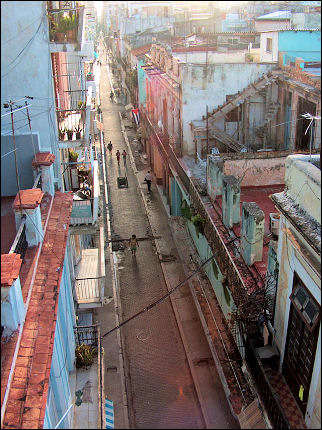
|
In Havana we get off the bus on Plaza de la Catedral. We drag our luggage, it's very hot. In a casa particular some phone calls are made and a little later we're on the 6th floor of a building on the Obispo, Havana's shopping street.
We explore the city. When we sit down in a park, we are immediately approached by Gilberto the musician. He tells us a long-winded story about women, his Spanish relatives and film tickets and then gives us a 2 peso coin with the immage of Ché Guevara. Unique and very special. Of course, he wants 2 convertible pesos in return, which are worth 60 times as much. We visit El Capitolio and have a mojito at El Floridita (with salted banana chips).
Next morning there's a terrible smell in the city. Juan José, the host of our casa, says "it's a kind of insecticide", it's diesel. Juan José also tells us about the high cost of coffee and tea (very scarce). The coffee the Cubans themselves drink, is mixed with black beans.
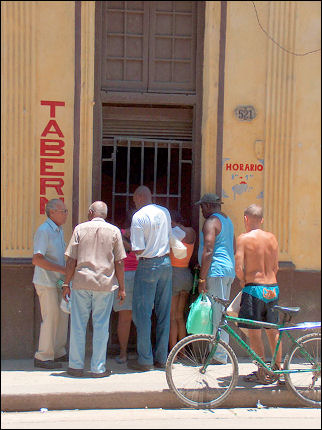
|
He warns us for Habanos who cheat tourists: they tell them that they don't have money for milk or flour and get tourists to buy it for them in a store, much too expensive. Later they share the profit with the store. These gentlemen are recognizable by their sneakers and gold teeth.
We walk via Prado to the Malécon. In the past, this must have been very beautiful. Now it's mostly dilapidated. The Prado has different architectural styles: Art Deco and Moorish. The street is paved with marble and there are lion statues and marble benches everywhere, with green trees between them.
Via Avenida de Italia we walk to the cigar workshop Partargas for a short tour. After a 9 months course, an employee has to make 150 cigars a day. They have to have the right size, should not be rolled too tight, etc. There are smokers who smoke cigars at random to test their quality. The salary is 250 Cuban pesos per month plus three cigars a day for private use.
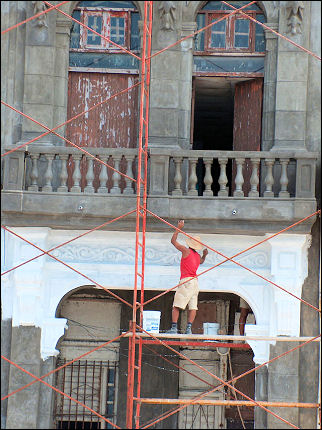
|
We walk in Old Havana with its renovated colonial buildings in bright colors. Many restaurants, patios and music. This is without a doubt the most touristic part of the city. On Plaza Viega we recognize a dilapidated town house. We show our travel book with the picture of the house to several people and it becomes quite a happening. The woman in the picture still lives here. She poses on the balcony for us.
We have dinner at Los Nardos opposite El Capitolio, at Prado 543. The interior is impressive and special: dark woodcuttings in Spanish-colonial style, high ceilings and fancy curtains. On the sides are cabinets with soccer trophees from 1926. It's wonderfully cool in here. What a relief.
The advantage of staying in a casa particular is the contact with the host and of course his advice. Juan tells us about a beautiful walking route in the city. We walk down Avenida Salvador Allende to its end. We see the Iglesia del Sagrado Casa, a Gothic construction, which is unusual in this dilapidated colonial neighborhood. Everywhere are stores with barred windows which sell meat, fresh fruit and other merchandise. Cubans are waiting in line outside, hoping to be able to buy something.
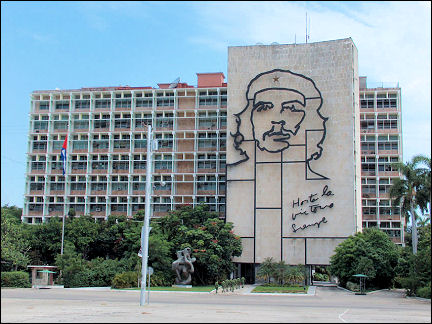
|
On Plaza de Revolucion we see a statue of José Marti and a granite obelisk. We have to pay to go up. We are impressed with a building which has the face of Ché Guevara on it; it's the Ministerio del Interior (Department of Interior Affairs).
We continue our walk on the wide Avenidia de los Pesidentes and on to the Malecón, toward Hotel Habana Libre. Unfortunately, its panoramic restaurant on the 26th floor is closed. Through the dirty windows we can see a little of the view of the city. A little farther we enter Hotel Nacional de Cuba. In the past, this was the place where big shots from Hollywood and Miami woud stay. We walk back to the Malécon. The view is bizarre: palatial houses, completely run down, Sovjet appartment buildings and renovated buildings all next to each other.
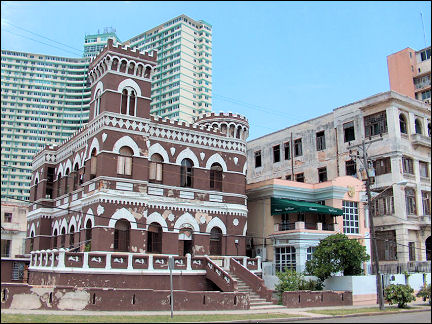
|
Walking on Malécon we notice more faded glory. The empty lots between the buildings were left by collapsed buildings. Some buildings are painted or are being renovated. Unfortunately the Museo de la Revolución is closed.
Next day we take a taxi to the airport to pick up our rental car. The driver tears through the city, overtakes cars left and right. Half way, he stops and switches off the meter; this way he earns a little extra (he has to report how much he's made in a day).
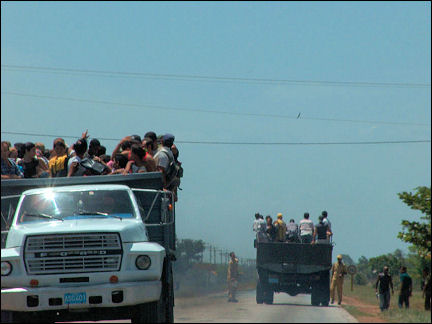
|
The road to Pinar del Rio is quiet and straight. On the way, people are waving near viaducts and intersections: they want a ride (Cuba doesn't have much public transportation).
We stop for some men with car trouble. Their car has its hood open and one of the men wants a ride to Pinar del Rio to get a mechanic. On the way, he tells us about his work. Then his real intention becomes clear: he wants to join us for a tour of a cigar workshop, to get a free cigar. We are not interested and all of a sudden he knows someone who lives near the next viaduct and asks us to drop him there.
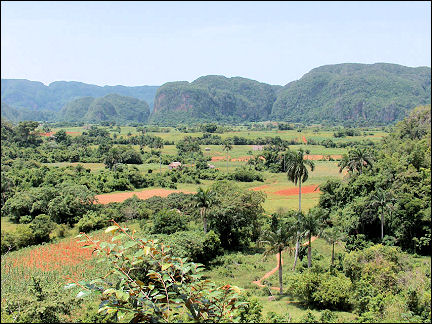
|
It's all clear to us now: we won't pick up waving men, but only women, children, cops and elderly people, who wait quietly underneath the viaducts. We take a secondary road to Vinales and then see the famous valley.
It happens that the tobacco farmer who lives in the light-blue house passes by and he shows us a good spot to take pictures. He himself has to walk all the way down. We see lots of horse carts and even ox carts.
Vinales
On horseback through a valley with rice, yuccas and tobacco
In Vinales a remarkable number of rental cars is parked; everywhere else we hardly encounter any traffic. There are many free-roaming dogs, cats, pigs and chickens.
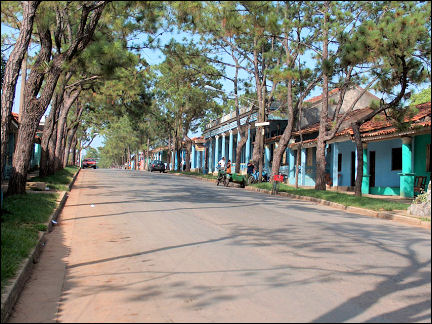
|
We stay at Maria's and Raoul's house, which is a casa particular. Maria arranges that friends of theirs take us on a horseback ride through the valley. Maria and Raoul are very hospitable. They only speak Spanish, but we manage to communicate with hands and feet. Maria cooks sumptuous meals and Raoul works at the tobacco plantation.
At night, it's very hot and by morning there's a power outage (happens often) and so the air conditioning also doesn't work anymore.
In the morning we visit Cueva del Indo, a cave with tunnels and stalactites. There is a lake as well, and a man with a boat is waiting for us at the landing. We take a boat tour and the man points out shapes in the rockwalls: snake heads, skulls, a bottle and a smoking man.
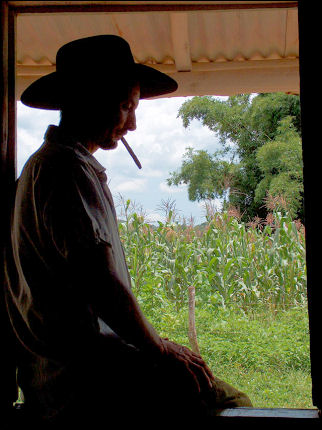
|
By 12:30 PM Chingo arrives at Maria's to pick us up. We walk through Vinales toward the valley. Chingo lives in a backstreet with his family. We are invited in and talk a little with help of a dictionary. It's an open, wooden house, it looks like the ranch houses we know from cowboy movies.
The three of us ride on horseback through the valley. On the way we see rice fields, banana palms (with diminutive bananas), yuccas (in our country they are house plants, here they're food), palm trees, tobacco plants and lots of corn. The horses like yucca and corn best and take bites left and right.
This really is the most beautiful landscape we have ever seen, it's so authentic. In the fields are oxen and horses. Chickens and pigs roam free. The ground is a fiery red.
We have a drink at Chingo's sister-in-law Neisy's home. She lives with her husband and two children in the valley. The shed in our garden is more habitable than their house: four poles and some planks. No electricity, no water, nothing. Just lots of animals, which will be eaten eventually.
The drinks are presented in coconuts: coconut juice with rum and lemon. Meanwhile, it starts to rain heavily; the horses are brought into the house. The sister-in-law speaks English and tells us about the lives of farmers (everything goes to the state) and about the voucher system that is used for grocery shopping.
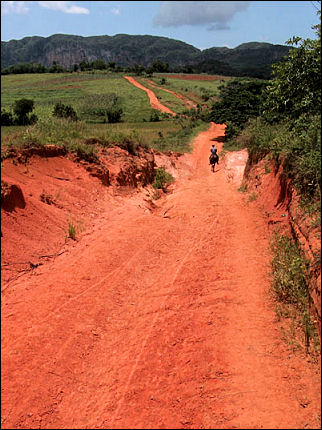
|
We ride to the caves. There we leave the horses by a bamboo bush. A little climbing takes us to the entrance of the cave. A man with a lamp meets us here, he'll be our guide. We enter the pitch-dark cave, it's like a petrified rice field: water with narrow ridges to walk on. We glide and stagger, holding hands with our guides.
Eventually we reach an underground lake. Alexander takes a swim, I feel a little uncomfortable in the company of these two gentlemen. As a prank, they switch off the lights, it's darker then I've ever seen. It's a special and also weird experience, to be in a dark cave with two strange men.
We return to our horses. On the way we see avocado trees. Chingo picks an avocado for us. We ride up a hill where we have a great view. Because of the rain, the road is in bad condition, the horses wade through mud up to their knees.
We have coffee at Chingo's home with his wife. Home-roasted coffee from the valley. The best we ever had. They show us pictures of their daughter at her 15th birthday. In the pictures she wears a kind of bridal gown against different backdrops. In Cuba (and everywhere in Latin America, ed.) fifteenth birthdays (quinceañero) are especially festive, they mark the onset of adulthood.
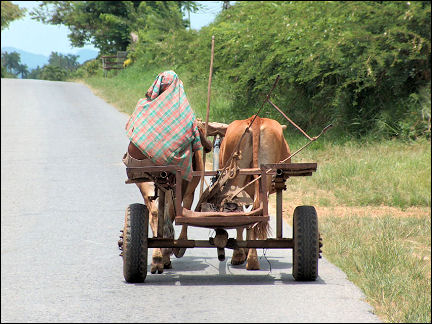
|
Next morning we leave. We give a ride to two Slovenians who are on their way to Havana. We drive via the Mural de la Prehistoria to Vinales. This mural was commissioned by Fidel Castro; we're not overly impressed.
After dropping the Slovenians in Havana, we drive to the Jaquey Grande, Cuba's only highway. It has six lanes and is in terrible condition, with many bumps and lumps; here and there we encounter another car. Mopeds and bicycles ride against the direction of the traffic. We pick up a taciturn cop on the way and drive to Playa Larga.
Playa Larga
The Indian village and crocodile farm are not worth a visit
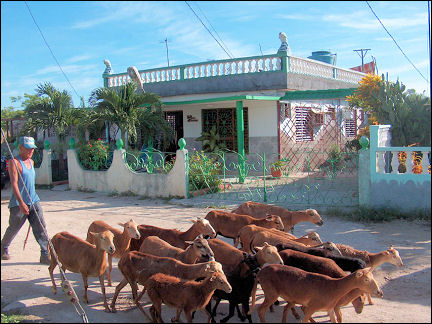
|
The surroundings are flat and wet. We pick up a grandfather and a woman. They talk a lot in Spanish. We ask them about a casa particular in Playa Larga. The woman gives directions, via a sand road with colorless houses we arrive at a green house. It's here. Spanish chique.
We walk to the beach for a swim. In the past, this was a beautiful sea resort, but now it's dilapidated, with many parking spots (but for who?). That night, we have crocodile for the first time in our lives.
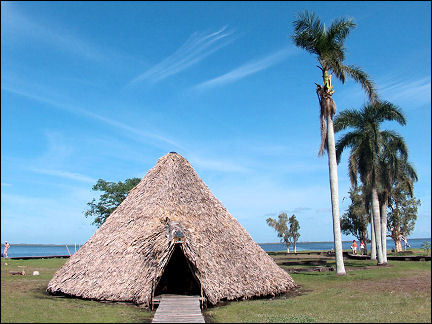
|
Next morning we drive a little distance back the way we came, to Jaqüey Grande. A speed boat takes us to Laguna del Tesorol Guama. A Taino Indian village was built there. Sculptures illustrate the way they lived.
Next we visit the Criaderi de Cocodrilo. If you like animals, it's best to avoid this place. A little Bambi lies lonely on a small meadow with a can of water. A little farther there's a show with a mini crocodile, which has a rope tied around its jaw, with which it's swung around. In the back, there are 60 or so large crocodiles in a kind of pond. Neither the Indian village nor the crocodile farm are really worth a visit.
We drive to Cienfuegos. Two helpful ladies, who we give a ride, direct us to our casa. A vague type watches our car. The casa seems okay, but somehow we don't feel comfortable here, despite the information in our books, which tells us that this is a worthwhile place to visit. We decide to drive on to Trinidad.
Sierra del Escambray is a beautiful route, partly along the sea, but the road is in bad shape. On the way we have different hitchhikers on the backseat all the time.
Trinidad
From behind barred windows people whistle at us
Juan in Havana gave us an address in Trinidad. A helpfull kid bicycles ahead of us through the town. Our casa is full and a different man accompanies us to another address. This is a wonderful casa in an old landmark, with a courtyard. It's a beautiful building. But we have to pay a lot for the help. We feel cheated once again.
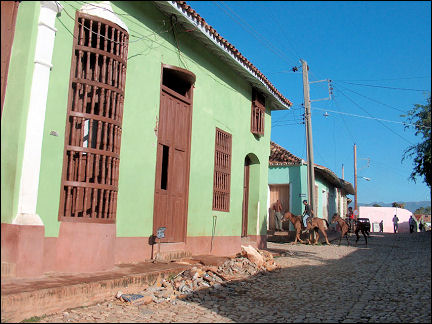
|
It's a lot hotter here. We explore the town. From behind barred windows people whistle at us and hang their arms out of the windows, hoping to receive soap, money or anything, really. It's quite annoying.
Children surround us all the time, asking for soap. Trinidad is beautiful, but it's clear that tourists have spoiled the place and that doesn't leave a positive impression of a city.
We have a drink somewhere; a washed-out band plays hits without enthousiasm. In the afternoon it rains heavily. During dinner in our casa we decide to have another look tomorrow morning and leave after that.
We get up early to explore the town in the cooler morning. Near the Iglesia Nuestra Señora we climb a hill to get a view of the town. According to our travel book the church was going to be restored, but it looks even more rickety than in the photos.
After an hour we have seen most of Trinidad and leave the casa. Our hostess brings a box with embroidery and crochet work, but we thank her and leave. When we drive through Trinidad, we see nicer neighborhoods than the one we ended up in. Outside the famous center of town everything looks nice and lively. Too bad.
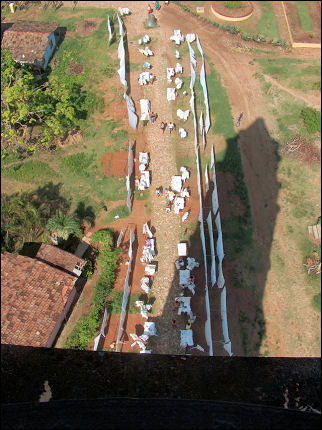
|
First we drive to Torre de Iznaga in Valle de San Luis. For the first time, there are road signs (in Cuba one usually has to drive by one's own sense of direction). The "parking guards" are waiting for us again, just like the stalls with embroidery and crochet stuff. It looks like an old-fashioned detergent commercial, with all those flapping cloths and sheets.
We climb the tower and admire the view: a green, mountainous landscape. In the past, the rich stood here watching the slaves work on their plantations. On the way back we give two sweaty grandfathers a ride to Trinidad. These guys deserve soap. We continue our drive to Topes de Collantes.
Our rental car has problems with steep roads. At Pico San Juan, at an altitude of 1147 m, is a great panoramic lookout where one can see Trinidad in the distance and even the shoreline.
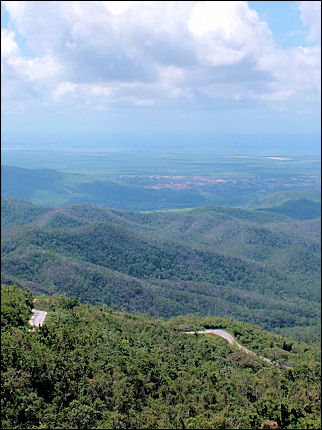
|
The roads to Manicaragua are all bumps and lumps; hurricane Dennis wrought havoc here, many fallen trees. Despite this, it's an extremely beautiful route.
We drive via Matagua to the A1, the highway. We have it almost all to ourselves. Sometimes it has six lanes, sometimes oncoming traffic passes closely. So we have to watch out all the time. The highway ends in Tuguasco, the rest is still under construction.
The surroundings of Ciego de Avila, pineapple city, are green, with a lot of sugarcane and palm trees. We find a casa in Florida. Because we're too late for dinner there, we go to a palador in the city instead.
In general, food in Cuba is the same everywhere, but there are regional differences. Fruit lovers are served well with many different kinds of fruit juices.
Camagüey
An atmospheric city with a lot of activity
The surroundings of Camagüey are also green and there are many trees. We enter the city on a wide street; there are signs here, too. We visit a local market with lots of vegetables and fruit and walk to Plaza San Juan de Dios, with an old hospital and a pink-yellow restaurant, Campana de Toledo.
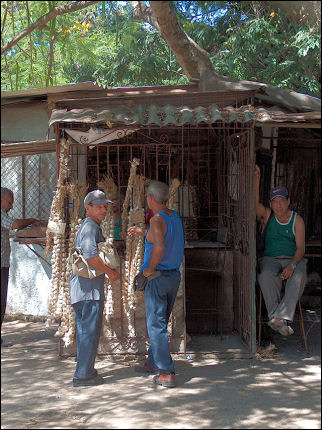
|
At Parque Agramonte we pass Casa de la Trova (a music café). At the neo-Gothic Iglesia del Sagrado Corazón de Jesús, Jesus is parked outside against the wall, hanging on his cross, as well as Mary and some of the disciples, because inside the church is being restored. The site foreman shows us the church interior. There are many birds inside, which shit on the floor.
Camagüey is an atmospheric city with a lot of activity, there are small offices all over the place. Our travel books warn us for con artists in this city, but we don't see any. There also are supposed to be Tinajones (large earthenware containers to collect rainwater)everywhere, but we hardly see any.
We meet Pedro, who sells Cuban vanilla slices. On a day, he sells around 300 for 2 Cuban pesos a piece. It is a good and smart way to earn some quick money. Pedro speaks English well. He wants to leave Cuba as soon as possible, to be free. He had a job in Varadero for a while and knows there is a lot more in the world. He tells us that the communist system doesn't stimulate people to get ahead in their jobs, because there never is a financial reward.
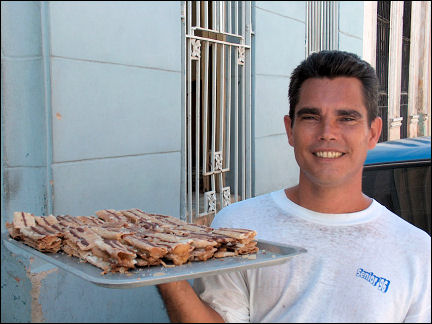
|
Via Las Tunas we drive through a green, rolling landscape with many palm trees, sugarcane and rice to Bayamo. While we drive through Las Tunas, we see a lot of art and sculptures, it looks like a nice city at first sight. But we don't explore it, because we want to go to Baracoa (in the farthest east of Cuba) and we have to plan our time here carefully.
After Las Tunas the landscape gets yellow and dry. On the way we see a truck; it looks as if it is carrying a pudding, but it turns out to be offal that shivers: intestines and cow heads.
Bayamo
Life is good here: a lot of sun and beer
In Bayamo it takes a while to find a casa. A woman on a bike bumps into our car; bikes here don't have brakes, people brake with their feet. Eventually we find a casa (from the long list we found on the internet). Villa Rose-Mary. It's a great find; it has a patio, air conditioning, a garage, etc. Inside, it looks like a hippy home.
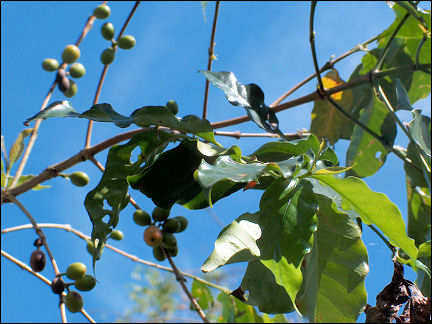
|
Ramon and Margaritha are lively talkers: "No problem!" His brother and their own son live in Miami. We have a great dinner with them at night. Ramon and Margaritha tell us about life in Cuba. For Cuban standards, they're well off. They own a motor bike, so every now and then they can go on a vacation (to Santiago de Cuba and Baracoa).
In Baracoa life is good, according to Ramon; a lot of sun and beer. In the afternoon we take a stroll in Bayamo and watch the Plaza de la Revolucion being sweeped. Two ladies are making their daily sweeping rounds, with large brooms they sweep the whole square according to a fixed pattern.
Sierra Maestra
Everywhere in the valley chickens, pigs and goats roam free
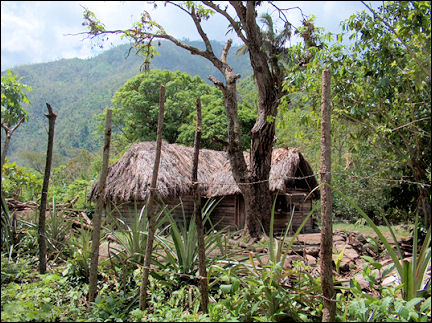
|
We get up early to visit the Sierra Maestra. It's hard to find our way on this route, lots of junctions and also unpaved roads with large potholes. The car is not really a climber and it growls all the way.
At the village of Providencia the road climbs again and now there are even more obstacles: goats and cows on the road. Every time we gather a little speed, we have to brake for animals.
Bartolomé Masó lies in a valley. The way down is very steep; how on earth are we going to get up again later? At an information point at the entrance of the park we meet a guide who speaks English well (he was an English schoolteacher).
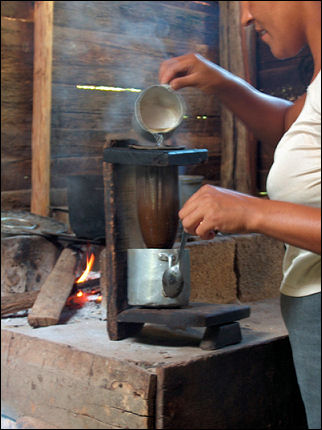
|
Unfortunately, we can't go to Pico Turquino, Castro's headquarters during the revolution. Hurricane Dennis did a lot of damage here, too and the path to the headquarters is no longer accessible.
We walk to a farmers family who grow coffee and roast the beans themselves. On the way we see the national flower of Cuba, the mariposa, which has a delicious scent. We have to cross the river a couple of times, via large grey rocks. We see how coffee beans grow and everywhere chickens, pigs and goats roam free.
The farmers family live in a hut of palm leaves they built themselves. Inside it's wonderfully cool. The chickens roam in the house, but the family has television. They show us how coffee beans are roasted. After they're roasted, they're thrown in a hollow tree trunk where they are crushed and ground with a stick, as in a mortar.
Alexander has to grind coffee himself. Then, coffee is made in a precursor of our coffeemaker. The coffee is at least as tasty as the coffee we had in Vinales.
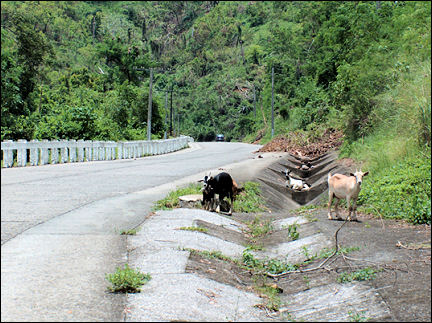
|
Half way the first hill, the car breaks down and I have to walk all the way up. Alexander lets the car roll down the hill. A little later he appears again, with the car, which growls like a monster. On a steep stretch, I get back in the car.
El Cobre
On Cuba there are as many abortions as there are births
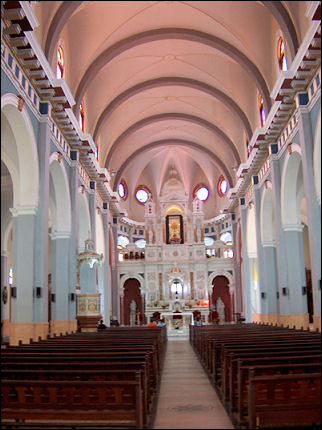
|
Next morning we leave for Santiago de Cuba. On the way we see many bull-breeding farms; the landscape is still pretty and green. In Palma Soriano we take the direction to El Cobre. This is the only basilica in Cuba and a famous pilgrims place. In the basilica sits a statue of the Virgen del Cobre. We leave our doors locked: the vendors almost sit on our car in their attempts to sell us statues of the holy virgin or flowers.
We park the car and enter the basilica. There are many pictures of abortions. In Cuba there are as many abortions as there are births. Everyone touches the statue of the Virgen and leaves flowers. El Cobre is in good repair and actually not very old: it dates from 1927. The pilgrims house next door is not a clean place to stay.
Santiago de Cuba
The colorful houses stand out
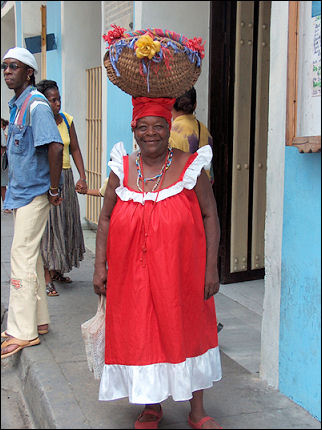
|
We immediately notice how colorful the houses and electric light signs are in Santiago. Few cars, but it's lively and busy. Near the Casa de la Trova we see a big black woman in a traditional dress with a basket on her head.
Via Padre Pico we walk up a flight of stairs to get a view of the city, but it's a little disappointing. Or is it the annoying kid who wants to give us a tour?
Parque Céspedes is a beautiful square on which sit Hotel Casa Granda and the Cathedral de Nuestra Senora de la Asunción. On Plaza Dolores we buy a bag of salted peanuts and watch people while we recover from the heat.
The best thing here is Libreria la Escalera, a bookstore owned by Eddy Tamayo. Books sit on long shelves, to which photos and business cards are attached.
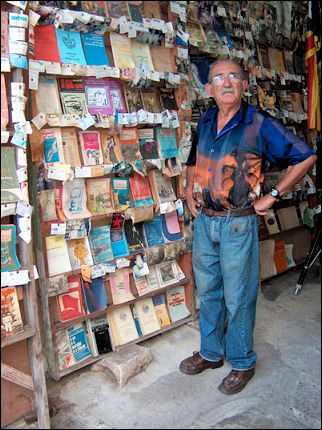
|
Judging by the pictures, Buena Vista Social Club performed here. We just heard that the singer died yesterday, so this is a weird experience.
Our casa hostess Maria del Carmen cooked a delicious meal, which also looks festive with spring onions on top of the meat.
While we have dinner, the whole family sits around us, watching us eat. It makes us uncomfortable. By evening, a huge thunderstorm with lots of rain brings some cooling.
Baracoa
Every now and then, someone comes to sell fruit
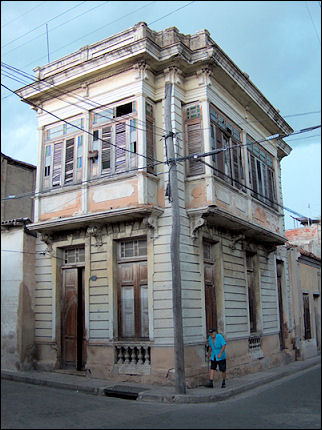
|
To Baracoa. Via La Maya we drive to Guantanamo and from there along the coast to Baracoa. This is supposedly the best road. Hitchhikers give us directions. The vegetation here is different, there are cactuses along the road everywhere.
Near Cajobabo we turn inland and drive via meandering roads up the mountain. There are beautiful valleys here. The closer we get to Baracoa, the more subtropical it gets, with palm trees, cacao trees, green and dense forest. Taking hitchhikers is very convenient, they lead us directly to the address Juan gave us.
We're lucky: the room is available. Meanwhile, Alexander got sick and runs a fever. Our casa host goes out to get bread and his sister makes lemon tea with lots of sugar. By the end of the afternoon we go and take a look at the beach.
The beach has black sand and is rather filthy, but still it's kind of crowded. People are playing volleyball and diving. It's nice to sit here for a few hours and watch what's going on.
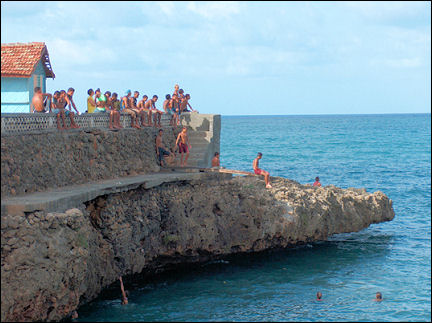
|
Next day, we drive to Maguana beach, 22 km north of Baracoa. It is supposed to be paradise. The surroundings are green, damp and tropical. After some searching, we find the beach, but then the weather changes. It's overcast and there is a strong wind, blowing garbage on the beach, which all of a sudden isn't so paradisaical anymore; there is nobody else here.
We return to Baracoa, and brave the beach under a reed parasol. Every now and then someone comes to sell pineapple or other fruit.
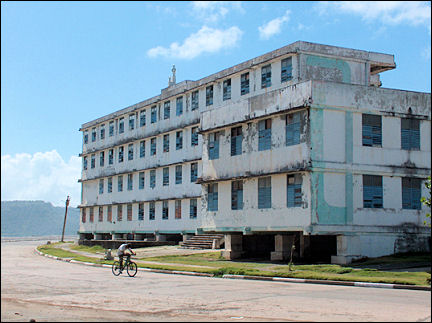
|
Baracoa is a special town with many old wooden houses and cheerless Soviet apartment buildings. Hotel Castillo Seboruco lies at an altitude of 40 meters above the town and has a great view. But we have to show our passports to get a drink. That's a little too outrageous for us.
In the evenings it's lively and crowded; the Casa de Trova here is wonderful. It's a great town to recuperate for a couple of days.
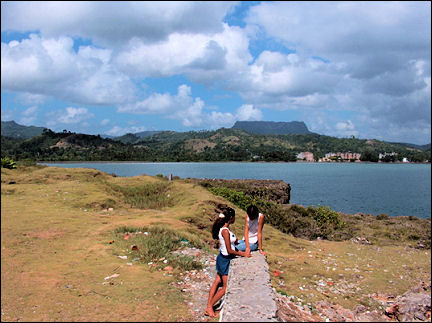
|
Next day we have bad luck, Baracoa is plagued by a tropical rainstorm and the weatherforecast says it will last another day. We decide to start our trip back. We need gas, but because of the torrential rains, all bicycle cabs are taking shelter under the roof of the gas station. After half an hour we can continue on our way.
Because of the heavy rainfall, it's hard to drive in these mountainous surroundings; all kinds of stuff fall down and we can't see the potholes. Once we leave the mountains, the rain stops. We take the Autopista back to Bayamo. Every now and then we have to brake because of crossing cows.
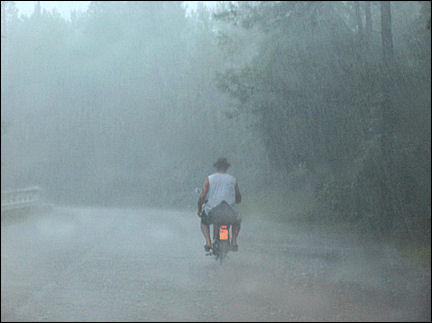
|
In Contramastre we can stay with a family who sell meat. Alexander inspects the room: there is offal all over the house, it smells terrible and it's black with flies. Waving friendly at them, we "flee" to Bayamo. There's probably a place to sleep there.
Ramon and Margaritha help us to find a room. Next morning we leave for Morón, near Caya Coco, for a nice day at the beach. Ramon and Margarita give us a packed lunch. A hitchhiking cop stays with us all day. It's a long way to Morón.
Caya Coco
The police only allow Cubans in who work here
It's hard to find a casa here, the prices are also much higher than elsewhere in Cuba. This is probably because of the many tourists who are on their way to Caya Coco. Eventually we find a casa, a kind of garden house. Our hostess' brother, Noëlvis visits us. He works on the Caya Coco beach and we decide to join him tomorrow.
At night it's crowded in our house: the wall is black with termites. Our hostess exterminates them with an insecticide. But at night, new termites disturb our sleep: they decided to use our bed as a bridge to the other wall. Next morning, the hostess promises to take care of them once and for all.
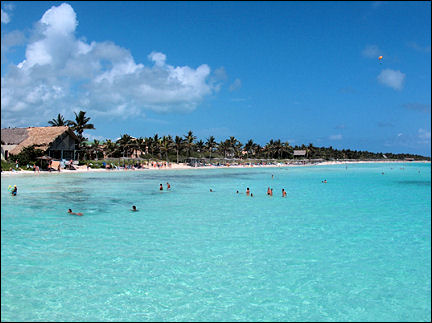
|
We drive to Caya Coco with Noëlvis in the back seat. At the entrance gate to the peninsula, policemen are checking papers. Only Cubans who work here are allowed in Caya Coco and, of course, tourists. The road to the peninsula is a long dam. Discarded Dutch buses drive back and forth.
We can easily spend the day under a palm-leave parasol. The beach is white and the water is turquoise. At 11 AM at boat takes us to a coral reef and we go snorkeling. We see beautifully colored fish and many jellyfish. Unfortunately not much coral.
Later in the afternoon we want to have a bite and we take Noëlvis and a catamaran to a few beach restaurants, but nobody has any food. Nothing was brought today. It's bizarre to be in a tourist resort and not be able to buy food. Eventually we last on a can of Tukola all day.
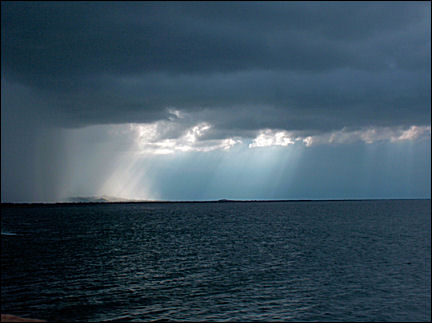
|
During the way back, the weather changes: a heavy rain shower. In the distance we see some pink specks: flamingoes.
Next morning we leave early to visit Pueblo Holandés, a village with houses that remind one of Germany. The village was supposedly built because Fidel Castro's wife likes this architectural style so much.
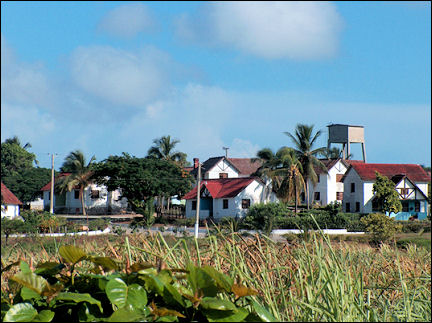
|
We drive via Santa Clara to Matanzas. The surroundings are beautiful, with soft velvet green hills. We have become a taxi company and now pick up our last hitchhikers on this trip. It's a family: father, mother, three children, all together on the back seat.
Matanzas
Piet Heyn conquered the Spanish Silver fleet here in 1628
In Matanzas we ring Isma's doorbell. She has a very large house, where she lives with her husband and dachshund Sacha (the dachshund is Cuba's national dog). She invites us in. Isma's husband is a lawyer and their house has been decorated in good taste, with lots of art and 1950s furniture. Unfortunately, she doesn't have room for us, but after a few phone calls she finds us a room at Merilyn's, on the edge of the city.
Merilyn comes to pick us up. She also has a reasonably big house, where she lives with her husband, daughter and mother. She used to work in Varadero, where she earned a lot of money. She invested all of it in the house. She and her husband sleep in the living room, so they can rent out their bedroom. Merilyn is a modern woman, she tells us that clothes are very expensive. She only has one set of underwear, which she washes every night.
We're lucky: it's carnival in the city. In the evening there's a parade with floats. Unfortunately, as happens often on Cuba, the weather changes and it rains. But it's still a special parade. It's the most important festival of the year. Merylin tells us that many people don't even have enough money to buy a drink during carnival; others save money all year long for this festival.
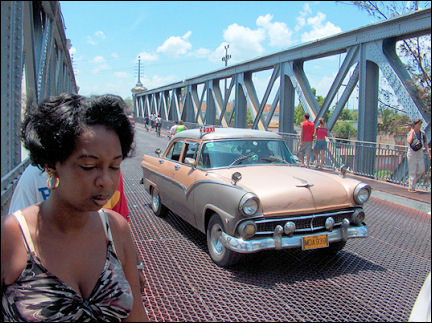
|
Next day we take a look at the city by daylight. Matanzas is a port town, where the Dutch sea captain Piet Heyn conquered the Spanish silver fleet in 1628. Many buildings in the city are dilapidated, but there are also traces of Art Deco buildings. The beach isn't great, but there is a bay where the Matanzasans go for a swim.
We see several tourists, who will leave from here again as well. Matanzas is near Varadero airport. This is our last day in Cuba, tomorrow we leave for Holland. Friends of Merilyn who want to earn some extra money, will take us to the airport in an old-timer. It's a wonderful country, with a nice mix of nature and culture.